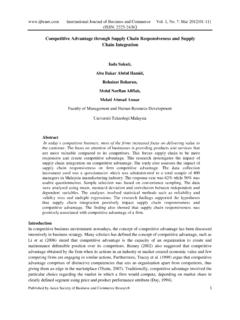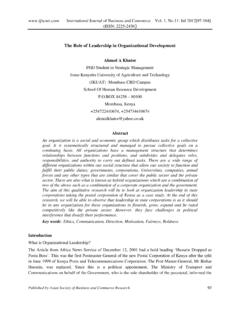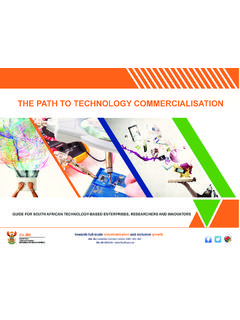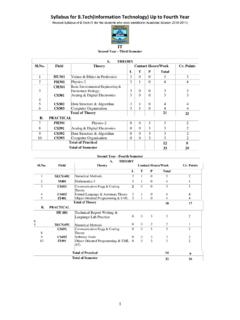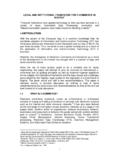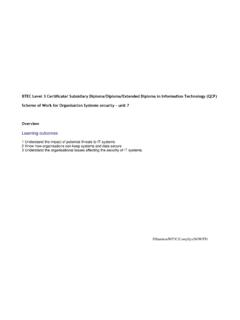Transcription of Factors Affecting the Success of Youth Enterprise ...
1 International Journal of business and commerce Vol. 1, : Jun 2012[61-81] (ISSN: 2225-2436) Published by Asian society of business and commerce Research 61 Factors Affecting the Success of Youth Enterprise Development Funded Projects in Kenya; A Survey of Kigumo District Muranga County Lawrence N. Kimando (Corresponding Author) Jomo Kenyatta University of Agriculture and Technology Box 62000-00200, Nairobi, Kenya School Of Human Resource Development Entrepreneurship and Procurement Department Phone: +254-710288415 E- mail: Mrs. Grace Wachera Njogu Kimathi University College Box 375, Mweiga, Kenya Faculty of commerce Phone: +254-722-686720 E- mail: Dr.
2 John M. Kihoro Jomo Kenyatta University of Agriculture and Technology Box 62000-00200, Nairobi, Kenya Faculty of Science; Statistics and Actuarial Science Department Phone: +254-715-973820 E- mail: International Journal of business and commerce Vol. 1, : Jun 2012[61-81] (ISSN: 2225-2436) Published by Asian society of business and commerce Research 62 Abstract The research investigated Factors Affecting Success of projects funded by Youth enterprises development projects in Kenya using a case study of Kigumo District. The study indicated that most of those who succeed in entrepreneurship are either trained on the kind of businesses they venture into or continue business training as they progress.
3 Therefore, for the YEDF to succeed, both short and long term measures must be embraced. From the findings, the study concludes that skills in entrepreneurship, business planning and financial management must elaborately be imparted before any funds are disbursed by the board. Keywords: Youth , training, Youth Enterprise Development Fund, unemployment. 1. Introduction Background of the Study Youth definitions are contextual, depending on the social, cultural, political and economic environment. According to Durham, Deborah (2000), the concept Youth is a social shifter , it is a relational concept situated in a dynamic context, a social landscape of power, knowledge, rights, and cultural notions of agency and personhood.
4 The experiences of Youth in various socio economic and political conditions and their outcomes largely define Youth . Certain experiences such as war, conflict, poverty and the HIV/AIDS pandemic blur the social divide between Youth and adult. Within these environments, young people constantly cross the frontier between childhood and adulthood, as they actively create and recreate their roles in the face of changing conditions (Boeck and Honwana, 2005). While these views construct Youth as a fluid concept, other definitions look at Youth as static category in the society , with distinctive responsibilities based on their age. Consequently, Youth -hood is viewed as a specific stage between childhood and adulthood when people have to negotiate a complex interplay of both personal and socio-economic changes in order to maneuver the transition from dependence to independent, take effective control of their own lives and assume social commitments (UNESCO, 2004).
5 The United Nations defines Youth as persons between 15 and 24 years. The World Health Organization (WHO) identifies three categories of Youth adolescents (10-19), Youth (15-24 years), and young people (10-24 years). The African Union (AU) considers Youth as persons between 15 and 34 years. In Kenya, there are various aged-based definitions of Youth . NYP defines Youth as persons aged 15-30 years. This definition is universally accepted and applied by international agencies involved in Youth programmes and activities. Most African governments use this definition as a basis for developing their specific age markers, which often reflect high upper age limits in account of the physical, psychological, cultural, social, biological and political aspects, which explain the Kenyan Youth situation.
6 The new Constitution defines Youth as all individuals in the republic of Kenya who have attained the age of 18 years but have not attained the age of 35 years (GOK, 2010). The Youth development programmes which the government has been implementing target persons aged 15 to 35 years. Lack of consistency in the definition of Kenyan Youth reflects the difficulty that most African societies have in specifying the age bracket of Youth . In African societies, responsibilities such as marriage are more important in defining the category where one belongs - adult or Youth . Biological age has been used to define policies and laws of inclusion and exclusion, in International Journal of business and commerce Vol. 1, : Jun 2012[61-81] (ISSN: 2225-2436) Published by Asian society of business and commerce Research 63 contest such as obligatory schooling, right to vote, obtain identity cards and driving license and drink alcohol (Hansen, Karen, 2008).
7 The exclusionary tendencies of policies targeting Youth have denied Youth opportunities to contribute in development and also exposed them to tight regulations whose interpretation and implementation is left to the law enforcing authorities. Rather than promote young people s well-being and development, certain policies have been used to constrain and deny them rights which are integral to their transition process. Essential, Youth transition is presented as a linear, psychosocial development process starting in late childhood, which progresses in a piecemeal fashion towards the conventional goals of adulthood (Barry, Monica (2005). According to them, the four main transitional stages include: Leaving the parental home and establishing new living arrangements; completing full time education; Forming close stable personal relationships outside the family; and testing the labour market, finding work and possibly settling into a career, and achieving a more or less stable livelihood.)
8 These transitions are interconnected. For instance, leaving parental home and setting up a personal home require an independent source of income, and to reach this stage, a young person generally has to have acquired qualifications and to have qualifications and to have succeeded in demonstrating his or her skills in the labour market or some equivalent subsection of the society (United Nations, 2007). The transition model assumes a predictable linear progression to mainstream endpoint-adulthood (Barry, Monica 2005). Ironically, the transition between home and work has become less discontinuous with many young people delineating the course of their lives (Leccardi, 2005 cited in Hansen Karen, 2008).
9 The uncertainty of the process compels young people to draw on diverse resources (economic, social cultural and political), depending on where and who they are in gender and class terms, as they negotiate their everyday lives and orient themselves toward the future (Hansen Karen, 2008). Significantly, debates about Youth have raised concerns about the existence of Youth as a distinct stage of life, since the realities facing most young people have negated the theoretical description of Youth -hood. According to Bynner et al (1997 cited in Barry, Monica (2005), Youth is just an additional bridging stage between childhood and adulthood to exemplify the protracted transition brought about by tighter labor market restrictions on school leavers, extended education and often compulsory training.)
10 It thus offers a convenient sociological bridge between the widening poles of childhood and adulthood in the Western world (Barry, Monica, 2005) This sociological bridge is dynamic, and sometimes too weak to support Youth to cross over without falling off course. In the contemporary society , a large proportion of young people do not experience the transition that the previous generation took for granted when they left school and went straight into full-time jobs. Thus, they enter adulthood much earlier than defined chronologically and biologically by dint of the responsibilities and roles they assume in the absence of proper functioning labour markets and in the face of changing social and political conditions. For Africa s Youth , experience in adult responsibilities begins early, since children actively participate in productive tasks, paid labour, household chores and taking care of younger siblings (Riesman, 1995 cited in Honwana and Boeck, (2005); and United Nations, 2007).


